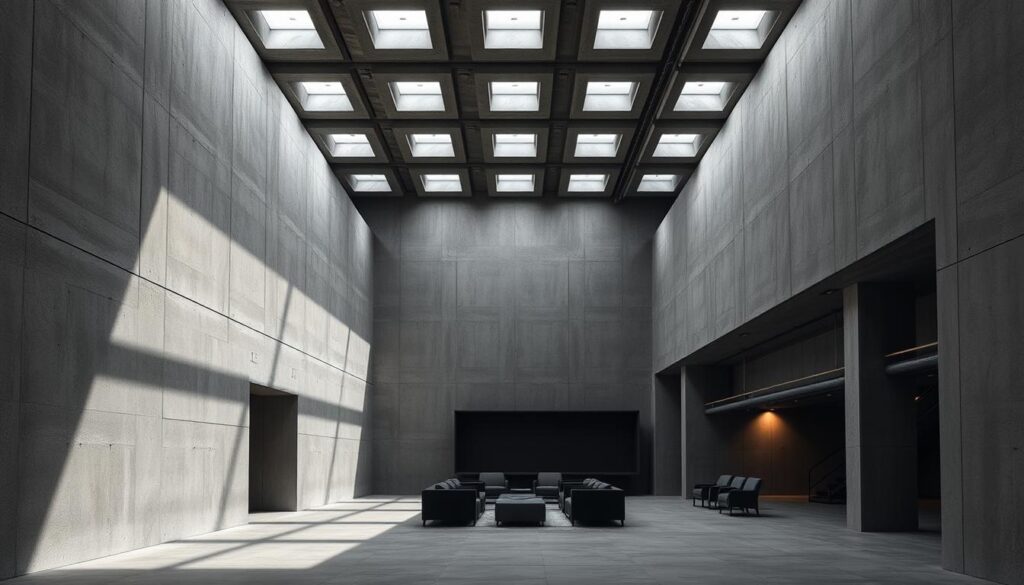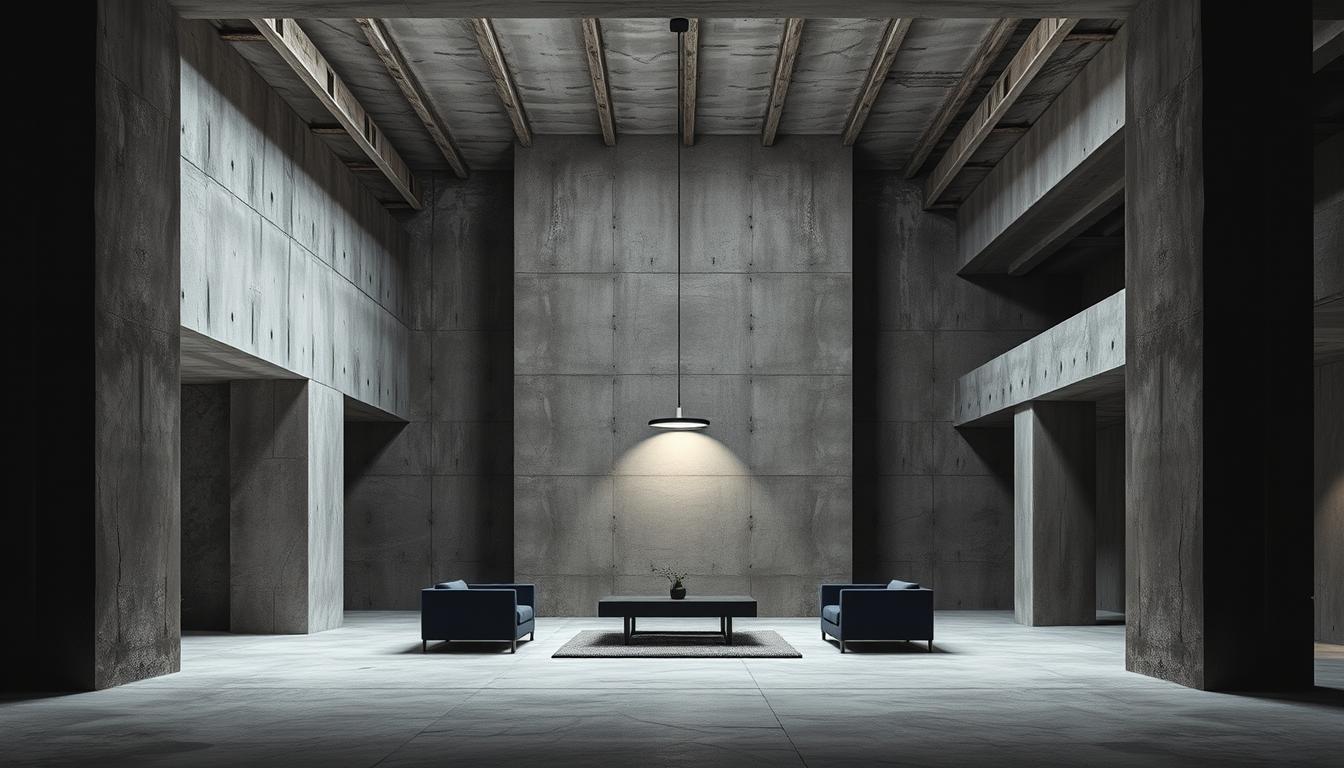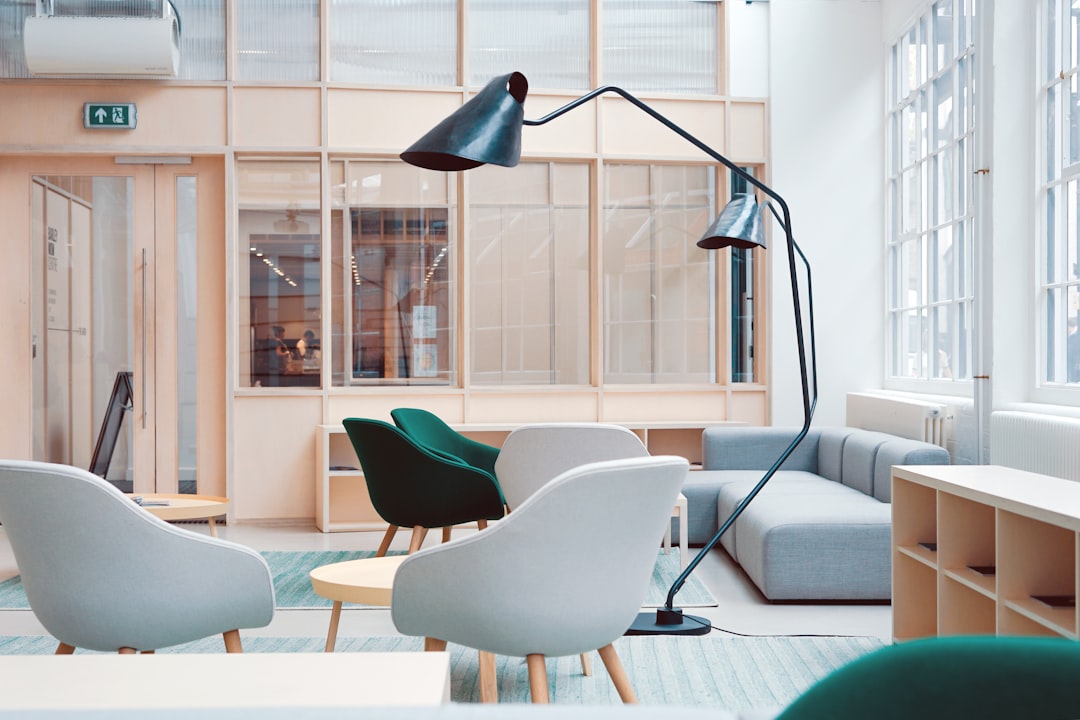Did you know that brutalist architecture is now a popular interior design trend? It’s known for its raw, unfinished look. This style has won over many with its mix of function and modern looks.
In this article, we’ll see how brutalist interior design can add a bold, rugged feel to today’s homes. Using materials like concrete, metals, and reclaimed wood makes spaces both modern and functional. For more on creating stunning brutalist interiors, check out our guide on embracing brutalist design.
Key Takeaways
- Brutalist interior design emphasizes raw, unfinished materials.
- Incorporating industrial-style lighting enhances the brutalist aesthetic.
- Balancing brutalist elements with softer textures creates a welcoming atmosphere.
- Using eco-friendly materials aligns with the sustainable aspects of brutalist design.
- Minimal ornamentation is a hallmark of brutalist interior design.
Understanding Brutalist Interior Design
Brutalist interior design comes from minimalist architecture and industrial chic decor. It’s known for using raw materials and focusing on function over fancy looks. This style is all about simplicity and avoiding too much decoration.
Definition and Characteristics
Brutalist design uses materials like concrete, steel, and wood in their natural state. This makes spaces feel real and authentic. It puts function first, making things look good but not too fancy.
This style is about unconventional shapes and simple colors. It often sticks to neutral tones and earthy shades. This creates a bold yet simple look that grabs your attention and makes you think.
Historical Context
Brutalist interior design started in the 1950s as part of a bigger architectural movement. It began in Europe with buildings made of raw concrete and strong structures. Soon, people started using these ideas for their homes and offices too.
The 1950s were a time when people wanted simple and useful things. Brutalist design was a new, modern choice that fit well with the times. It was a response to the fancy styles before it, offering something fresh and practical.
Key Features of Brutalist Interiors
Brutalist interiors love the look of unfinished spaces. They often show off exposed concrete and industrial parts. This style focuses on being practical and true to its construction.
Raw Materials and Textures are key in Brutalist design. Using raw concrete, steel, and wood makes spaces feel rugged yet beautiful.
Raw Materials and Textures
Brutalist design is all about using raw materials. Concrete design is big, often left raw to show its texture. Other materials like brick, stone, and steel add to the industrial look.
- Exposed concrete walls and ceilings
- Steel beams and ductwork
- Reclaimed wood accents
- Minimal ornamentation
Unconventional Shapes
Brutalist interiors often have shapes that break the mold. They use geometric forms, irregular shapes, and asymmetry. These shapes make spaces unique and interesting.
- Geometric forms like triangles and hexagons
- Irregular structures that defy conventional architecture
- Asymmetrical compositions that create visual interest
Brutalist interiors use raw materials and unique shapes. This creates a look that’s both tough and stunning. It’s not just about looks; it’s about being honest and real in design.
Color Palettes in Brutalist Design
The colors in brutalist design are chosen with care. They add to the modern and raw look of the space. These colors also match the building’s features, making the whole look cohesive and stylish.
Neutral Tones and Earthy Shades
Neutral tones and earthy shades are key in brutalist design. They range from concrete grays to earthy browns, showing off the raw materials. Neutral tones keep the space clean and simple, letting the materials stand out.
Earthy shades, however, add warmth. They soften the tough look of brutalist buildings. This makes the space feel welcoming, yet still true to the brutalist style.
The Role of Monochrome
Monochrome schemes are also great for brutalist design. Using different shades of one color creates a smooth flow. Monochrome palettes make a space feel bigger and more connected, by removing the mess of many colors.
Also, a monochrome scheme can show off the details of a brutalist space. For example, gray shades can highlight concrete’s rough beauty. Blues can bring a calming feel to the area.
Furniture Choices in Brutalist Spaces
Furniture in brutalist interiors is chosen for its mix of minimalism and function. It shows the style’s love for raw, unpolished looks. When picking furniture, focus on simplicity, durability, and raw materials.
Minimalism Meets Functionality
In brutalist design, furniture is more than looks; it must work well. Pieces are minimalist, with clean lines and no fancy details. For example, a brutalist sofa might have a simple frame, made from leather or untreated wood.
Brutalist furniture is known for:
- Raw, unfinished materials
- Simple, geometric shapes
- Focus on function over looks
- Little decoration
Iconic Brutalist Furniture Brands
Some furniture brands are key to brutalist design, showing modernist aesthetics. They make pieces that are both beautiful and useful. Their materials and designs follow the brutalist way.
Notable brands include:
- Le Corbusier, known for minimalist, functional designs that are modernist icons.
- Eames, famous for mid-century modern furniture with brutalist touches, like raw materials and simple shapes.
- Mies van der Rohe, a minimalist pioneer, whose furniture is simple, functional, and industrial.
Choosing furniture from these brands helps create a brutalist space. It’s both beautiful and practical, showing the style’s love for raw, unpolished looks and modernist aesthetics.
Lighting in Brutalist Interior Design
The raw and rugged nature of brutalist interiors demands a thoughtful approach to lighting design. Lighting can significantly enhance the aesthetic appeal of a space, making it feel more welcoming and functional.
Natural Light Considerations
Natural light is a crucial element in brutalist interior design. It can highlight the raw textures and materials characteristic of this style, creating a sense of openness and connection to the outdoors. When designing a brutalist space, it’s essential to consider the orientation of windows and the use of skylights or larger window panes to maximize natural light.
Maximizing Natural Light:
- Use large windows or skylights to bring in natural light.
- Minimize window treatments to keep the natural light unobstructed.
- Consider the orientation of your space to optimize natural light intake.
Choosing Fixtures That Fit
While natural light is important, artificial lighting is equally crucial in creating a well-lit brutalist space. The choice of lighting fixtures should complement the industrial chic decor, often featuring metallic materials and simple designs.
| Lighting Fixture Type | Description | Best Use |
|---|---|---|
| Pendant Lights | Simple, metallic designs that add a touch of industrial chic. | Over kitchen islands or dining tables. |
| Track Lighting | Flexible and adjustable, ideal for highlighting specific design elements. | In living areas or galleries. |
| Floor Lamps | Minimalist designs that provide ambient lighting. | In corners or beside seating areas. |
By carefully selecting lighting fixtures that align with the brutalist aesthetic, we can create a space that feels both rugged and refined. The key is to strike a balance between form and function, ensuring that our lighting choices enhance the overall design without overwhelming it.
The Emotional Impact of Brutalist Spaces
Brutalist architecture and design are known for their honesty. They can deeply affect our emotions. Understanding how these spaces shape our feelings is crucial.
Creating a Sense of Grounding
Brutalist design uses raw materials and focuses on function. This creates a grounding effect. It feels comforting because it shows the structure’s true nature.
Materials like concrete, wood, and steel connect us to the earth. This connection brings stability and calm. Natural light adds to this, creating a play of textures and shadows.
Balancing Harshness with Comfort
Brutalist design may look tough, but it’s not cold. Designers add comfort elements like soft textiles and warm lights. This mix creates a special emotional connection.
In modern design, finding this balance is essential. It makes brutalist spaces welcoming and emotionally supportive. By combining honesty with comfort, we create spaces that are both striking and supportive.
Tips for Incorporating Brutalism Into Your Home
Want to add brutalism to your home decor? There are practical steps to follow. Brutalist design loves raw, unfinished looks and focuses on function. By adding brutalist touches, you can make your space stand out.
Start Small with Decor Elements
Decor is a great way to bring brutalism into your home. Look for items like concrete, steel, or reclaimed wood. A concrete vase or steel sculpture can be a bold statement piece.
Choose decor that’s both useful and simple. Brutalist design is about more than looks. It’s about things that work well and look good too.
Working with Architects and Designers
For big projects or major changes, team up with architects and designers who get brutalism. They can blend brutalist elements into your home’s design. This makes your space both beautiful and practical.
When working with pros, talk about your vision. Show them brutalist designs you like and how you see them in your home. This way, you get a space that’s truly yours.
Start with small steps and maybe get help for bigger projects. This way, you can enjoy brutalism’s raw beauty and practicality. It fits your style and needs perfectly.
Case Studies: Successful Brutalist Designs
Brutalist designs use raw, unfinished elements to create striking spaces. They embrace concrete, steel, and other industrial materials. This has led to remarkable structures and interiors.
Residential Examples
Brutalist homes often have exposed concrete and a minimalist look. The Le Corbusier’s Villa Savoye is a key example. It shows how brutalist architecture can work in homes.
In homes, brutalist design uses raw concrete walls and industrial lighting. For example, a living area with concrete can have sleek furniture. This balances the rough look of the materials.
Commercial Spaces
Brutalist design also works well in commercial areas. Offices, restaurants, and stores have used it to create striking and functional spaces.
The National Theatre in London is a great example. It has a bold, concrete exterior and interior. Such designs make a big impact on visitors.
To use brutalist design in commercial spaces, balance raw elements with refined ones. Mix concrete with traditional materials and textures. This creates a unique and inviting environment.
Common Misconceptions About Brutalism
Brutalism is a design movement known for its raw concrete and simple shapes. It’s often misunderstood by both critics and fans. Let’s look at what makes brutalism different from other styles.
Brutalist vs. Minimalist Design
Many think brutalist design is the same as minimalist design. But they’re not the same. Minimalist design aims for a clean look by removing extra details. Brutalist design, on the other hand, uses raw materials and complex shapes.
A minimalist architecture project might have simple colors and lots of empty space. Brutalist design, however, uses exposed concrete and industrial elements for a rough look. Critics say brutalism is about honesty and authenticity in design https://onarchitecture.substack.com/p/no-one-understands-brutalism.
| Design Element | Minimalist Design | Brutalist Design |
|---|---|---|
| Materials | Smooth, finished surfaces | Raw, unfinished materials (e.g., concrete, steel) |
| Form | Simple, geometric shapes | Complex, often unconventional forms |
| Aesthetic | Clean, uncluttered | Rugged, industrial |
Appropriateness in Different Settings
Some think brutalist design is only for big buildings. But it works in many places, like homes and offices. It’s all about fitting the design to the setting.
In homes, brutalist design can add a cozy, industrial feel. In offices, it can make a bold statement. When done right, brutalist design is both useful and beautiful.

In summary, brutalist design is often misunderstood because of its bold look. By knowing the difference between brutalist and minimalist, and using brutalist in various places, we can see its true value in architecture and design.
The Future of Brutalist Interior Design
Brutalist interior design is changing, blending modern looks with its classic, raw feel. It’s adapting to new trends and tech, staying relevant in today’s architecture.
New Directions in Brutalism
New trends in brutalist design mix raw materials with cutting-edge tech. This creates a unique blend of old and new. There’s a big push to add sustainable practices, keeping the style’s edge while being eco-friendly.
Sustainable Practices in Brutalist Design
Sustainability is key in brutalist design now. Using eco-friendly materials and methods helps reduce environmental harm. This makes brutalist spaces look better and supports green values.
Brutalist design is evolving, making spaces that are both eye-catching and green. By mixing modern looks with eco-friendliness, it stays relevant and meaningful for the future.



